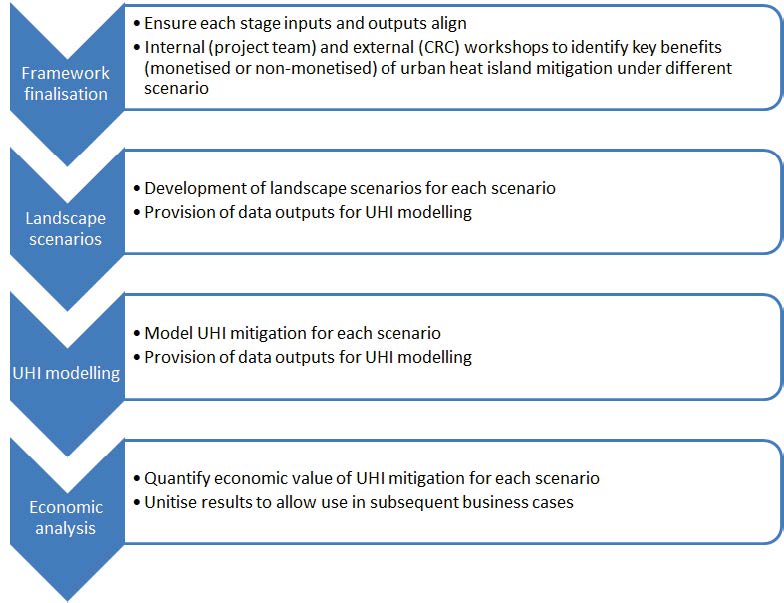Economic value of urban heat mitigation (IRP2-WP6)
Overview
This work package has been exploring the UHI mitigation produced from different scales of investment in urban greening, and will quantify the value of this benefit in dollar terms, for example by reduced mortality/morbidity, reduced energy demand and increased productivity. Increasing levels of investment in green public open space, and associated investments in passive and active irrigation of those spaces, produce increasing benefits in UHI mitigation.
In Tranche 1 CRCWSC research was able to show the clear physical urban cooling benefits of different levels and types of urban greening, but there is currently no credible estimate of the economic value of the cooling produced under different scenarios of WSUD adoption. Therefore there is currently no way to use UHI mitigation in any policy position or business case for greening cities and integrated water management policy changes.
In this IRP2 work package led by Professor Nigel Tapper from Monash University, the aim is to overcome this critical barrier in policy knowledge by combining expertise in economic assessment (UWA and RMCG), UHI modelling (Monash University) and urban design response (E2DESIGNLAB). Outputs will be dollar value estimates of the UHI mitigation value produced under different greening and integrated water management settings.
Final reports:
Tapper, N., Lloyd, S., McArthur, J., Nice, K., and Jacobs, S. (2019). Estimating the economic benefits of Urban Heat Island mitigation – Biophysical Aspects. Melbourne, Australia: Cooperative Research Centre for Water Sensitive Cities
Whiteoak, K and Saigar, J (2019). Estimating the economic benefits of Urban Heat Island mitigation– Economic Analysis. Melbourne, Australia: Cooperative Research Centre for Water Sensitive Cities
The list of possible areas for benefit-transfer has been fully developed in WP2.
Summary of project:
The below image depicts the approach followed:

Landscape Scenarios:
Four landscape scenarios involving the derivation of a range of physical variables critical for modelling were developed for the assessment. The landscape scenarios represent different levels of Water Sensitive Urban Design (WSUD) intensity, with associated levels of vegetation, perviousness, and water availability that ultimately affect the surface energy balance and drive the near-surface climate. The four landscape scenarios were defined as:
- No Water Sensitive Urban Design or whole of water cycle management;
- Current regulatory settings for WSUD/WWCM (base line);
- Proposed changes for WSUD/WWCM; and
- A targeted UHI mitigation scenario to achieve a desired cooling (e.g. 2 degrees on extreme heat days).
These four landscape scenarios were tested for three summer scenarios to understand the effectiveness of WSUD in different temperatures.
- Cool (~20˚C) summer days
- Average (~26˚C) summer days
- Extreme (~40˚C) summer day
The differences are then reflected in different thermal and moisture regimes in the local microclimate, which in-turn impact mortality, morbidity, energy use, and productivity.
Melbourne Case Study
The case study site was a greenfield development on the outskirts of Melbourne, comprising 33,000 urban residential dwellings; roads, commercial and industrial space; and both non-irrigated and irrigated public open space. The study site was selected based on availability of data and information required to develop the scenarios, and an outer suburb in western Melbourne was preferred as it tends to be drier and hotter than the eastern suburbs. The study focussed mainly on the benefits to the core residential area.
Biophysical and Climate Modelling
The biophysical modelling considered soil moisture, tree canopy area and other outputs of relevance to temperature. TARGET was used to model street level air temperature from a standard height of 2m (near surface) with a resolution of 30m. TARGET also provided the UTCI (Universal Thermal Climate Index) outputs to measure thermal comfort. Climate modelling was then undertaken to produce daily average minimum (overnight) and maximum (midday) temperatures for each scenario and three summer climate condition (cool, mild, and extreme). Various meteorological variables were used including, but not limited to, air temperature (˚C), relative humidity (%), and wind speed (km/hr).
Results:
- When considering the midday spatial patterns of UTCI difference across the residential area of the case study site, under scenario 4 settings, relative to no IWM, there is 2˚C of cooling almost everywhere during the cool summer conditions, but less effective cooling in mild and extreme summer conditions.
- In the residential area of the case study site, relative to current policy settings, Scenario 4 produced the most cooling, at 0.5˚C for the cool summer days scenario.
- The UTCI shows that it ‘feels’ like cooling of 0.8˚C when a cooling of 0.5˚C is achieved, meaning that WSUD is very effective at cooling the environment and improving human thermal comfort.
- WSUD is effective at mitigating heat impacts during moderate conditions but less effective at mitigating heat effects under very high temperatures.
Economic Modelling
An economic literature review on the valuation of the benefits in UHI mitigation was initially completed, and an economic framework developed.
The economic framework used in this analysis was a benefit: cost analysis (BCA) using a discounted cash flow method and 50-year time period. The modelling drew from economic and scientific literature to identify a range of costs linking heat and economic outcomes. Costs were attributed to different temperatures, and where a scenario produced daily temperature reductions compared to Scenario 2 (baseline), the reduction in heat-related cost reflects a benefit of that scenario. As such, the ‘avoided cost’ method was largely used to estimate benefits.
Results:
-
-
- Significant greening associated with plausible policy settings will produce meaningful economic benefits.
- At a case study level, Scenario 4 might derive a UHI mitigation value over $7.0m in present value (PV) for maximum urban greening under both high and average emission scenarios.
- For Scenario 4, mortality benefits and lower electricity use are the main drivers of benefits.
- These results indicate that UHI mitigation is one of many benefits that is produced by IWM investments related to urban greening.
- These results should be considered during formal benefit-cost analysis of IWM investments.
-